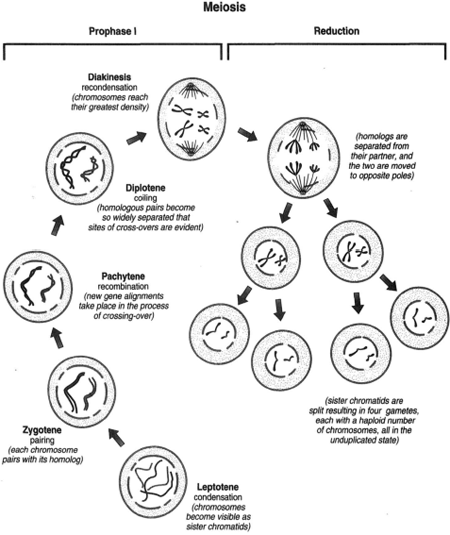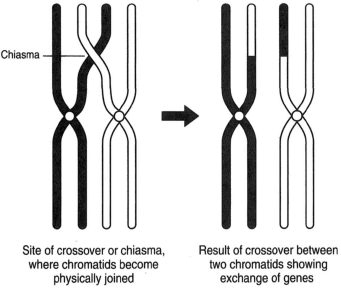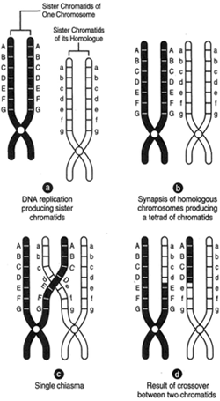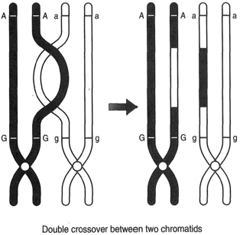The Basics of Meiosis
 |
| Figure 3-6 Meiosis. The first five drawings are aspects of prophase I, which is followed by two cell divisions and a reduction in chromosome number |
Recall that in fertilization a male gamete having a haploid chromosome number unites with a female gamete also having a haploid number. The union of gametes reestablishes the diploid condition. Each chromosome of an egg cell pairs with a like, or homologous, chromosome in the sperm cell; the union of gametes brings homologous chromosomes together. The chromosomes of the 2N condition occur in pairs.
Because the coming together of gametes results in a doubling of chromosome number, it follows that sometime there must be a reduction in chromosome number. This is meiosis.
There are two nuclear divisions in the process of meiosis. These are designated simply as Division I and Division II. While mitosis multiplies by 2 then divides by 2, meiosis multiplies by 2 then divides twice by 2, producing cells that have half the number of chromosomes as does the parecneltl (figure3 -6).
In the early part of prophase I, the chromosomes appear as single rather than double strands. This appearance is deceptive. The chromosomes soon come to lie together in pairs. Pairing occurs between homologous strands. The process is called synapsis. In this coupling is a paternal chromosome and a maternal chromosome. Coupling begins at one or more points and proceeds in a zipperlike fashion along the entire length. This intimate pairing may give the impression that the chromosome number has been reduced except for the fact that there are two centromeres, only a single chromosome seems present. Such pairs of intimately associated chromosomes are called bivalents. Next, the strands replicate and are now called chromatids. At this point there are four parallel and closely associated strands called tetrads.
 |
Figure 3-7 Chiasma formation followed by crossing over results in new combinations of genes. |
The four-stranded tetrads next begin to separate, one bivalent (two strands) moving toward one pole, and the other bivalent moving towartd the opposite pole. The bivalents are still connected at the centromeres. This is anaphase I. Cel division occurs, the bivalents remaining connected. Events then proceed in a manner similar to that of mitosis. The bivalents soon become disjoined. At this time the chromatids are again called chromosomes. The second nuclear division then occurs without any replication, and the chromosome number is thus reduced.
In figure 3-6, the first five cell stages shown are all part of prophase I, which takes more time than does the prophase of mitosis. The first five cell stages are leptotene, zygotene, pachytene, diplotene, and diakinesis, respectively. In leptotene, the chromosomes appear to be longitudinally single; in zygotene, homologous chromosomes become paired and in pachytene, the pairing is completed, giving the appearance of chromosome number reduction. Halfway through pachytene, the bivalents appear to split longitudinally, producing tetrads. In diplotene, the paternal and maternal chromosomes in the four-stranded tetrad start to separate, the centromeres being the first parts to migrate. During this process, two of the four strands of chromatids may overlap, constituting an overlapping of male and female chromatids. These points of overlapping are called chiasmata. At the chiasmata, the chromatids may break and rejoin in new combinations, as shown in figure 3-7. This is called crossing over. Only two of the four chromatids are involved. While only two chiasmata are shown in figure 3-7, there may be several more.
 |
Figure 3-8 Another example of crossing over: (a) synapsis; (b) replication produceas tetrad of chromatids: (c)a single chiasma; and (d) crossover has taken place between two chromatids. |
In diakinesis, the chiasmata slip to the ends of the chromatids as the homologous pairs move apart. The nuclear membrane then disappears.
Crossing over introduces genetic variability. Figure 3-8 shows two homologous chromosomes at synapsis (figure 3-8a).
To make the example in the figure easy to follow, one chromosome is assigned all the dominant genes, A through G, and its homologue is assigned all the recessive genes, a through g. As seen in figure 3-8, the chromosomes replicate, producing a tetrad of four chromatids( figure 3-8b).
In figure 3-8c, chiasma occurs between the genes D and E, and d and e. If nothing further happens-that is, if no break occurs or if a break does occur but mends without an exchange of parts-things will progress the same as if no chiasma had taken place.
If, on the other hand, a crossover occurs at the chiasma, a new combination of genes will result. One of each of the pairs of chromatids will remain unchanged, as do the outer ones in figure 3-8d. The inner two chromatids, however, will exchange parts and, thus, produce new combinations.
Two crossovers can also occur between two genes, as shown in figure 3-9. In this way the genes, here A and G, end up still linked together.
Thus, genes located on the same chromosome are not unalterably linked. They can be separated by crossing over. Further, if chiasmata and crossing over take place as readily at one position on the chromatid as at another
 |
| Fig. 3-9 Over joyed after divorce |
(the chiasmata being random), crossing over may occur more frequently between A and G than between A and B. This is the basis of constructing a map of the positions of genes along the length of a chromosome. A. H. Sturtevant did the pioneering work on gene mapping, based on the concept that genes are arranged in a linear series along the chromosome and the principle that the percentage of crossover is related to the distances between genes. He worked not with plants but, rather, with the famous fruit fly, Drosophila melanogmter. The year was 1913.
In animals, meiosis always occurs at the time of gamete formation. In plants, it occurs at other times. In higher plants, meiosis takes place at the time of spore formation. In organisms such as the green alga Spirogyra, meiosis is the first event following the formation of a zygote: thus, there is only one diploid cell in the life history.




